Where to Stay in Barcelona: A Complete Guide for First Timers
Wondering exactly where to stay in Barcelona for an upcoming trip to the capital of Catalonia? On our latest trip, we spent a week in Barcelona, stayed in two different neighborhoods, and explored just about every corner – or at least as much ground as we could cover in just a week- of the city center on foot.
In this guide to the best places to stay in Barcelona, we’re going to go through five of our favorite neighborhoods, with pros and cons for each, the neighborhood highlights that we enjoyed, and some specific places to stay that we like.
In the end, we hope that this detailed guide helps you find the perfect place to stay in Barcelona, whatever your travel style and budget might look like.
We have done our best to think about different styles and budgets, with accommodation options ranging from hostels to boutique hotels, because we recognize that your particular needs might be different than ours.
One strong perspective we have is that you should focus on finding the right neighborhood first, based on what characteristics you are looking for (e.g. central location vs. great food and drinks) then look for the right specific place to stay within that neighborhood.
That’s how this guide is organized – starting at the neighborhood level, then drilling down into specific hotels, hostels, and apartments.
Sound good to you? Let’s find you the perfect place to stay for your trip to Barcelona!


P.S.: Planning a trip to Spain? We have a detailed Spain itinerary plus guides to Barcelona, Madrid, Granada, and Sevilla to help you plan an amazing trip!
Disclaimer: Some of the links in this post, like hotel links, are affiliate links, meaning at no additional cost to you, we make a little bit of money if you click through and book. That being said, we would never recommend something to you that we don’t stand behind 100%.
Where to Stay in Barcelona: A Detailed Guide to the Best Places to Stay
As we said before, where you should stay in Barcelona largely depends on you – your budget, your preferences, and your style.
A family of four is probably going to choose a different place to stay than a pair of 20-somethings backpacking Europe on a gap year.
With that in mind, we’re going to go into the pros and cons of each neighborhood to give you the information you need to make the right decision, then give you some places to stay in each area for a variety of styles and budgets (boutique hotels, affordable hotels, apartments, and hostels).
Don’t have time to read the entire detailed guide below? Here’s a quick summary to get you off and running on your search for the best place to stay in Barcelona (in the right direction!).
- Our overall recommendation is to find a charming hotel or guesthouse in Gràcia, which is far and away our favorite part of Barcelona. Cobblestone streets, energetic plazas, and some of the best bars and restaurants in the city? Sign us up. If you want a nice affordable hotel, stay at La Casa del Sol or Hotel Barcelona 1882. If you want to stay in an apartment for a little more space, look at Be Mate Paseo de Gràcia.
- If it’s your first time in Barcelona, you can’t go wrong with staying centrally in l’Eixample. It’s right on the center of the city, conveniently located between the Old City and Gràcia, and it’s well connected to just about every place you’ll want to visit over the course of your Barcelona itinerary. This part of the city is full of great hotels – we like Hotel Casa Bonay (upscale boutique hotel) and Praktik Garden (a nice mid-range option).
- If you’re looking for a slightly different experience, look at El Born, a hip part of Barcelona that’s near the Gothic Quarter and waterfront, and is packed full of bars, restaurants, cafes, and more. It’s a good central location, and generally feels much younger than, say, the Gothic Quarter. For an affordable guesthouse, look at Casa Consell. For a more upscale hotel, look at the Mercer Hotel.
Where We’ve Stayed in Barcelona
It probably makes the most sense to start this guide with our own experience.
On our most recent trip to Barcelona, we stayed in two separate neighborhoods over the course of our week in the city – in Gràcia, which we loved and highly recommend – and on the border of l’Eixample and El Raval, which is about as central as it gets.
Gràcia is at the northern edge of the city center, but is well-connected to the main sights in Barcelona via the metro (there are two metro stops nearby that connect you to the Old City and La Sagrada Familia as well as the airport/train station).
This is our top pick in terms of places to stay in Barcelona because it has the best combination of bars, restaurants, and coffee shops, location and connections to the rest of the city, and feeling like locals ACTUALLY live here.
We stayed at Casa Gràcia, which we have mixed feelings about. It was a great location, walkable to everything in Gràcia and literally one minute from both great coffee and a metro stop.
But the rooms and common areas feel like they’ve been slowly deteriorating for years, and the room we stayed in was a little… dirty. It has SO MUCH POTENTIAL, but it really doesn’t live up to expectations based on the pictures, which must have been taken immediately after a super deep clean.
Overall, we’d definitely stay in Gràcia again, but we’d find a different place to stay.
L’Eixample is another great location, though it’s not nearly as charming as Gràcia or, say, the Gothic Quarter. It’s the modern section of Barcelona, built as the city expanded past the original walls, and it looks more like Paris or another modern city than other parts of Barcelona’s center.
We stayed at TOC Hostel Barcelona, which is a “boutique hostel” that is essentially a hotel with a few dorm rooms and a common kitchen. It’s plenty nice, but don’t expect much space in your room.
Gràcia: Our Favorite Neighborhood in Barcelona
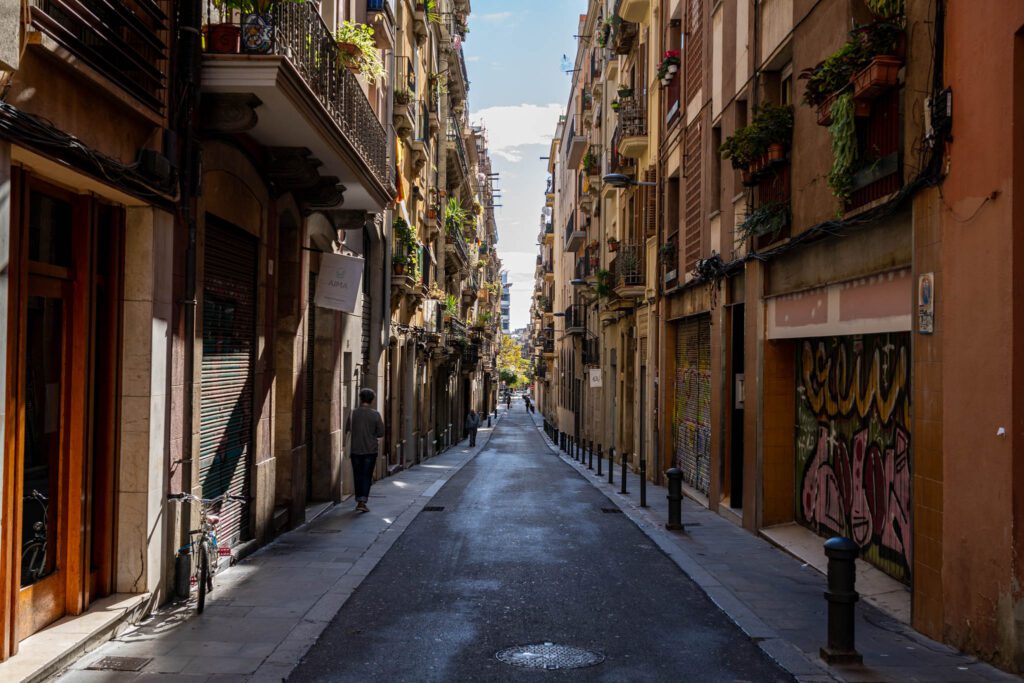
We stayed in Gràcia for the majority of our latest foray into Barcelona, and loved it. It will 100% be the place we stay the next time we find ourselves in the Catalonian capital, which is about as good an endorsement as we can give.
At one point, Gràcia used to be a completely separate town from Barcelona, and it’s easy to imagine that being the case as you stroll the streets early in the morning, before the hustle and bustle of Barcelona really gets going.
I’ve seen the word “bohemian” used a lot to describe Gràcia, and I’m still not quite sure exactly what the word means.
I think Gràcia is a little hipster, a little family-oriented with plenty of plazas and green spaces full of locals (and their kids and/or dogs) going about their days, and a lot charming and packed full of amazing food, drinks, and shops.
Gràcia is hip without falling into hipster cliches, managing to be both quiet and pedestrian friendly, yet also atmospheric and buzzing, as exemplified by the district’s infamous ‘Festa Major’, a raucous week-long street party that takes place every August.
In short, we loved Gràcia, and think it would be a great home base for exploring Barcelona, especially if you want to stay somewhere that isn’t exclusively for tourists (though there are plenty of those around pretty much everywhere in Barcelona).
Pros and Cons of Staying in Gràcia
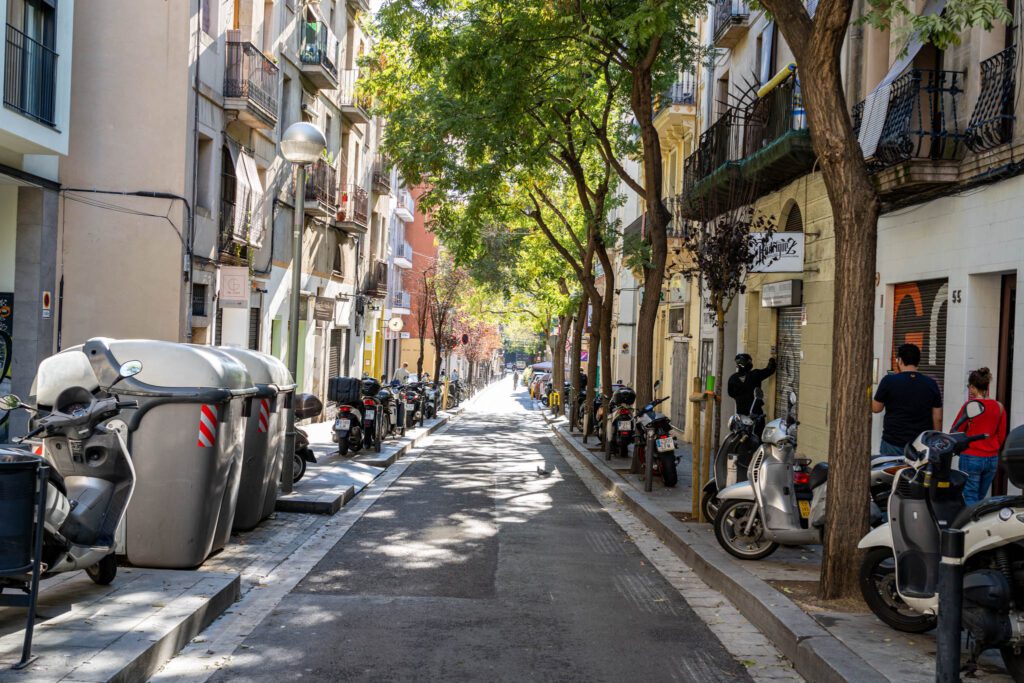
Pros:
- Great Transit Connections. There are two metro stops – Diagonal and Gràcia – that connect you to the L3 and L5 metro lines, which take you both downtown and to some of Barcelona’s main sights.
- Community Feeling. Obviously, as a tourist, you’re not really going to ever be a part of a community when you’re traveling. But it is very pleasant to sit on a plaza and watch as people go about their daily lives and feel like you’re immersed in local life, even if it’s just for a few minutes. The key is being respectful of that community – here’s how you can be a respectful tourist in Barcelona.
- Great Food and Drinks. Whether you’re looking for a morning cup of coffee or a nightcap, Gràcia has a pretty incredible array of places to eat and drink at all hours. It’s particularly energetic on warm summer evenings, when the outdoor terraces of nearly every bar and restaurant in the neighborhood are packed from 9:00 pm on.
Cons:
- Not Walkable to Ciutat Vella. While it’s walkable in terms of walking within the neighborhood, it does require a metro trip (or 30+ minute walk) to get to the Gothic Quarter and El Born.
- Not Many Places to Stay. There aren’t that many choices in terms of places to stay. There are a few hotels and aparthotels, but the vast majority of the area is residential (and we think that you shouldn’t stay in an Airbnb in cities).
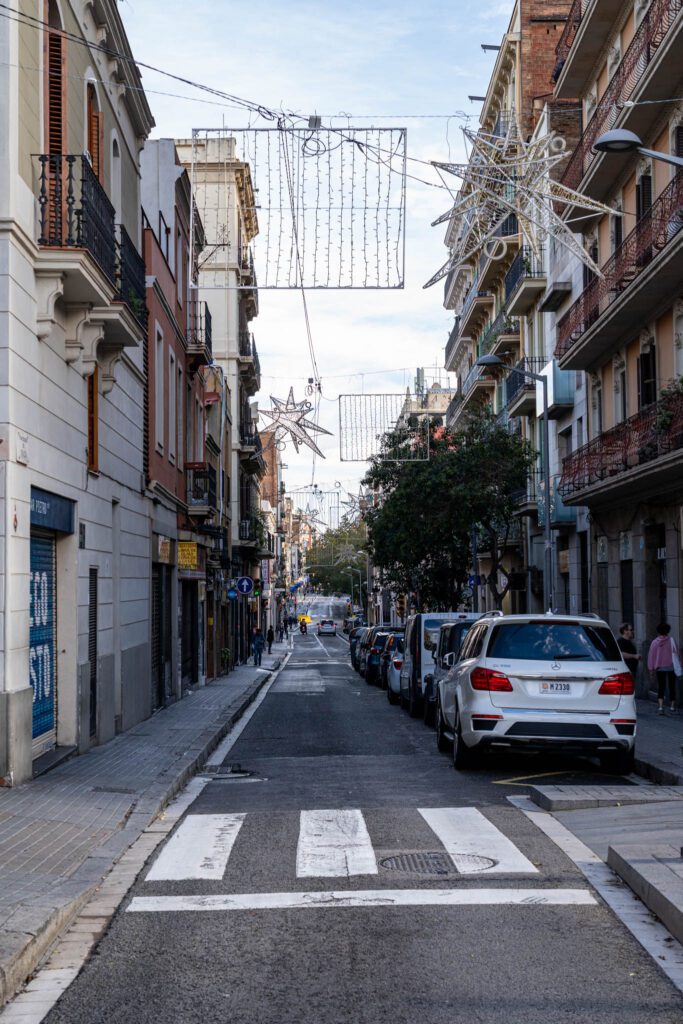

The Best Places to Stay in Gràcia
Here are some of our picks for the best places to stay in Gràcia.
Be Mate Paseo de Gràcia: Great Location with Hotel Rooms and apartments (with kitchens)
Right on Passeig de Gràcia (which means you’re two to three minutes from a metro station that will connect you to the rest of the city), this hotel/apartment mix has rooms split between hotel-style rooms with king beds that are surprisingly spacious, and apartments (one or two bedrooms), which means that they probably have an option that’s right for you, whatever your style and budget.
Some of the hotel-style rooms have private terraces (yes please!), some have balconies.
The apartments are spacious and stylish, with full kitchens (with ovens and coffee makers) and plenty of room to spread out and relax.
If we were to do a trip to Barcelona again, this would be where we’d stay.
La Casa del Sol: A Solid Mid-Range Guesthouse with Modern Rooms
Right in the heart of the best part of the neighborhood on the beautiful Plaça del Sol, this modern hotel has a couple of different variations of bright hotel-style rooms featuring minimalist décor, clean lines, and mini-fridges (but no kitchens).
Rooms are relatively small, but have everything you’ll need for a comfortable place to sleep while you’re out exploring Barcelona. And the common areas – like the rooftop terrace and light-filled lounge – will give you plenty of space to relax or get some work done (who wants to spend their entire trip in their room, anyway?).
It’s a very modern take on a guesthouse, which means contactless check-in, limited staff onsite, and a clean, minimalist design.
Hotel Barcelona 1882: A Beautiful Eco-Friendly Boutique Hotel
An eco-conscious boutique hotel in the heart of Gràcia, this beautiful hotel (recently renovated, too) is on the northeastern side of the neighborhood, closer to the Sagrada Familia than Passeig de Gràcia.
But it’s still within walking distance to everything in the area. Bike rentals, a nice pool, and a rooftop bar with views of the Sagrada Familia are a few of the things you’ll have to look forward to if you stay here.
Choose from king rooms, rooms with two twins, and triples and family rooms with space for three and four people.
Feelathome Mozart Apartments: Nice Spacious Apartments in a Great Location
A couple of blocks from Passeig de Gràcia (and the important Diagonal Metro Station, with two metro lines), this small apartment building has six apartments, all recently renovated and outfitted with air conditioning (a must-have for summer), full kitchens (with dishwashers), and washing machines.
If it’s available, grab the apartment with a terrace, where you can enjoy a sunset drink before heading out for a (late, because it’s Spain) dinner in the neighborhood. They have options with one and two bedrooms, depending on your group size.
Casa Gràcia: A Well-Located Hostel with Apartments
We stayed at this hostel / guesthouse, and have mixed feelings. It’s a hostel, with a set of apartments in a building a couple of doors down. The location is great, but the rooms feel like they haven’t been renovated (or deep cleaned) in five or more years.
For example, on the stove in the apartment we had, the lights that tell you how hot the burner is were completely burnt out, making the stove fairly useless.
Overall, it’s a great location and a surprisingly affordable place to stay, but be prepared for rooms that need some TLC.
L’Eixample: A Great Central Location Full of Stuff to Do, See, and Eat
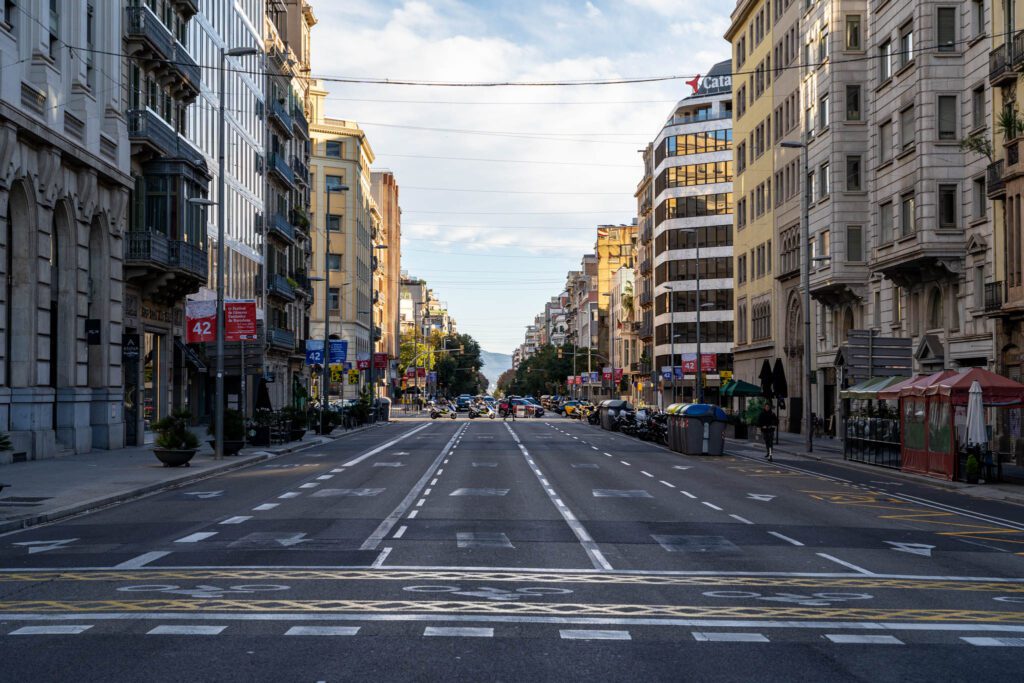
A reminder that we spent the second half of our latest trip to Barcelona using l’Eixample as our home base, and enjoyed it.
Though, I will say that we often found ourselves leaving the neighborhood for the day and returning at night to sleep, which is easy because it’s so central.
L’Eixample was built as Barcelona expanded beyond the old city walls to connect the suburbs (at the time) like Gràcia to the core of the city.
It was designed to be modern, and is characterized by wide, multi-lane boulevards lined with tall buildings with commerce on the ground floor and housing on top floors.
It’s much, much more leafy than the Gothic Quarter, but not as much as Gràcia. It’s much more relaxed and laid back than the Gothic Quarter, but not as much as Gràcia. It has more of a mix of tourists and locals, but not as much as Gràcia. See a pattern here?

In other words, it’s a compromise between the more laid back feeling you’ll find in Gràcia and the convenience you’ll get by staying more central. It’s superpower is being smack dab in the middle of the action. Which makes it an excellent base for exploring Barcelona.
It is worth noting that this particular neighborhood spans a wide area, basically all the way from Parc Ciutadella at its eastern end to the base of Montjuïc and Plaça d’Espanya to the west.
In general, we much prefer the area in the center of the neighborhood, just south of Gràcia and west towards Place de Catalunya.
This part of l’Eixample is full of tree-lined streets, places to eat and drink, and leans more towards Gràcia than Gothic Quarter in terms of its feeling.
Pros and Cons of Staying in l’Eixample

Pros:
- Central and Well Connected. There’s probably no better place to stay in terms of walkability and transit connections. You could walk almost anywhere from your hotel, though most people will prefer to save time and energy by taking the metro, which has multiple lines running through the area.
- Great Food and Drink Offerings. Coffee and food, in particular, are the winners here. Nightlife is a little lacking, but you can make the short journey to El Born for that.
- Tons of Places to Stay. Whether you’re looking for a luxury hotel or a charming, affordable guesthouse, this neighborhood has a plethora of choices for you to choose from. All styles and budgets can find the perfect place to stay here.
Cons:
- Expensive. Who could have guessed that the area where you’ll find the Prada store in Barcelona would also be an expensive area to stay? Lots of high-end hotels and shops here, which means you’ll likely be paying a little more than other places in Barcelona.


The Best Places to Stay in l’Eixample
There are a BUNCH of great places to stay in this part of Barcelona, here are a few that caught our eye.
Hotel Casa Bonay: A Beautiful Boutique Hotel
Based in a leafy area of l’Eixample, Casa Bonay is a stylish establishment with a mini-orchard on the rooftop and a beach hut inspired bistro. It also has a great coffee shop in the lobby – an outpost of local favorite Satan’s Coffee Corner.
The hotel is in a building from the 1800’s that has been completely redone by a local design firm, and now is one of the most stylish places to stay in the city.
Rooms are a bit below average in terms of size, but like many modern mid-range hotels popping up around the world, the idea is to sleep in your room, and use the hotel’s common areas as a place to relax, get work done, or get a quick meal in before heading out to explore.
They do have larger rooms, with seating areas and plenty of space to spread out, but you’ll be paying a premium. A couple of the rooms also have private terraces, some with outdoor showers (which we’re most definitely into!).
The hotel is also something of a hotspot for local creative types, who you’ll find hard at work in the hotel’s gorgeous common areas. Definitely recommended if you’re looking for a stylish place to spend your time in Barcelona.
Praktik Garden: A Leafy Mid-Range Hotel
The next three hotels on this list are all from the same group – Praktik – and they’re all super fun, we think.
Praktik hotels are among the best hotels in Barcelona. We really like the idea behind their hotels – each of their properties is designed around a central theme, and they give the modern traveler everything they need, nothing they don’t, all at a reasonable price.
This leafy hotel is a garden oasis right in the middle of Barcelona, just a few blocks from Las Ramblas (but far enough away, don’t you worry). Plants greet you as you enter the hotel and head to reception, and around every corner… PLANTS.
Rooms were refurbished recently, and they are cozy and compact, but that’s fine if you’re planning on spending most of your waking hours outside the hotel room.
Good WiFi, A/C and heat (for the surprisingly chilly – though short – Barcelona winters), and different room sizes for different budgets.
Praktik Bakery: A Mid-Range Hotel with an Onsite Bakery
The first ever bakery hotel (whatever that means). The second of the Praktik Hotels on this list is centered around one thing: bread.
There’s an in-house bakery called Baluard (which is why it’s a bakery hotel, I suppose), which is heavily featured in the hotel’s excellent breakfast buffet. We’re suckers for subway tile, so the rooms here are right up our alley.
Like their other hotels, they’re designed for modern travelers who don’t want much space, or the extra stuff that comes with an extra cost. Cozy, well thought out rooms at reasonable prices are the name of the game here.
Different room layouts and sizes based on your particular needs and budget live up to the practicality promised by the name. Everything you need, nothing you don’t (except, maybe, bread).
Pratik Vinoteca: A Charming Hotel for Wine Lovers
Situated in the heart of l’Eixample, Praktik Vinoteca is a hotel with a single-minded focus: wine!
There are over 900 bottles of the stuff on show in the reception area, and this hotel also boasts its own sommelier, and hosts wine tours and regular tasting events. The room types and layouts are similar to the other two Praktik hotels above, which makes sense.
Everything you need if you’re okay with spending your waking hours outside your hotel room, nothing you don’t, and a reasonable price to top it all off.
Yeah Barcelona Hostel: A Hip Boutique Hostel
We really like the trend of “boutique hostels”, which offer the best of both hostels (the social aspects) and boutique hotels (the stylish and private room aspects) all in a relatively affordable package.
Yeah Hostel is leading the charge in Barcelona’s hostel scene, and it’s in a fantastic location too. You’ll have access to all the common spaces, including a shared kitchen, and you’ll have your choice of dorm rooms or private double rooms.
TOC Hostel: Part Boutique Hostel, Part Mid-Range Hotel
Another boutique hostel, we actually stayed at TOC Hostel for the second half of our last trip to Barcelona.
It’s essentially a boutique hotel, and falls a little short on the social aspects we usually see in hostels. But it’s a sparkling clean and nice place, and it’s also in an excellent location. Private rooms and dorms to choose from.
El Born: The Best Part of the Cituat Vella
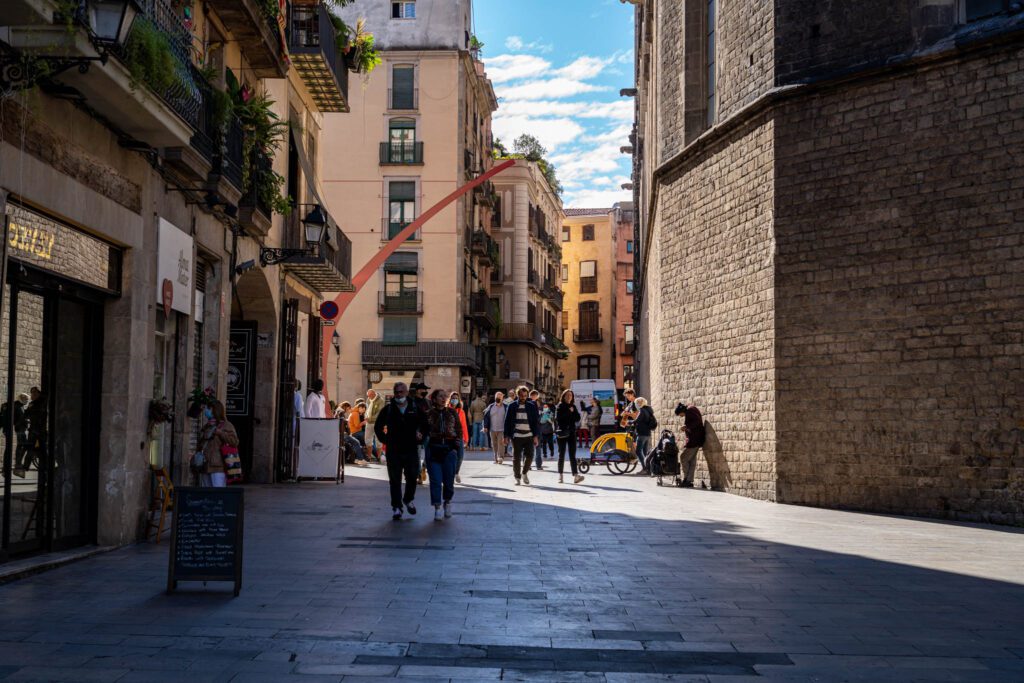
As we mentioned above in the geography section, the main part of the Ciutat Vella is made up of three distinct areas (plus Barceloneta, which looks and feels very different).
El Born is the easternmost section, and is actually made up of three different sub-neighborhoods (La Ribera, Sant Pere, and Santa Caterina – otherwise known as Sant Pere, Santa Caterina i la Ribera). But everybody calls in El Born, so that’s what we’re going to go with too.
El Born comes alive after dark, when people of all ages flock here for the nightlife.
It’s about as central as it gets without staying on Las Ramblas itself. To the east, you have Parc Ciutadella. To the west is the Gothic Quarter, the historic center of Barcelona.
South is Barceloneta, and if you head north you’ll run into Gaudi’s masterpiece and one of the most intricate and fascinating religious places in the world – the Sagrada Familia.
Pros and Cons of Staying in El Born
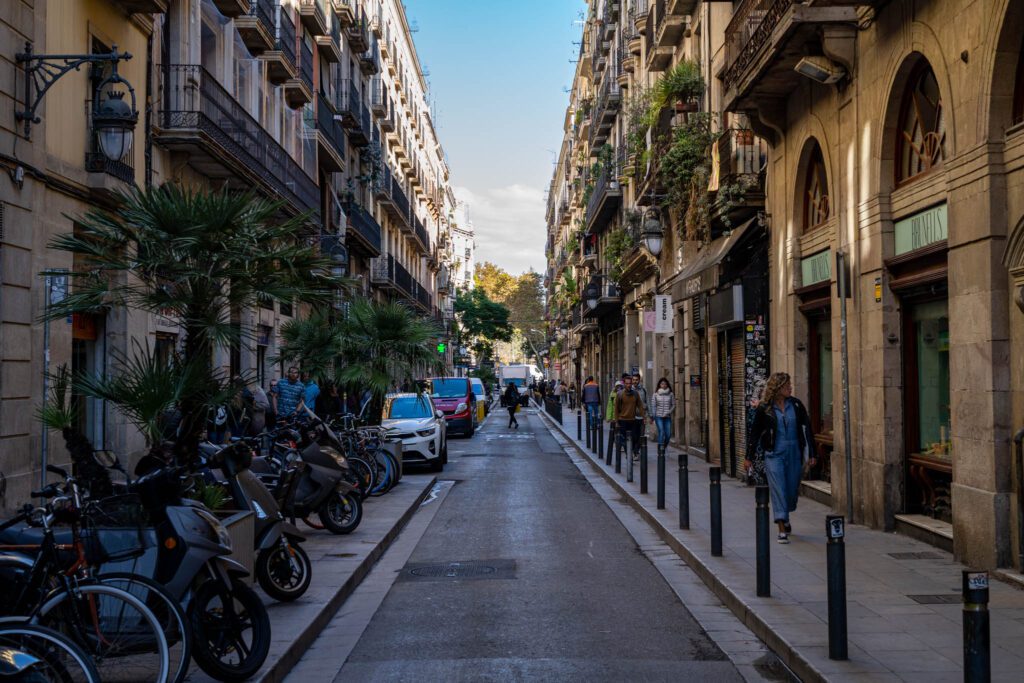
Pros:
- Great Nightlife. If you’re looking for cozy cocktail bars or places to go dancing until the early hours of the morning, El Born has what you’re looking for. Go after dark to see it at its most energetic.
- Super Central. You’ll be within walking distance of just about everywhere in Barcelona, and for the places you can’t walk (Parc Güell, for example) you can hop on the metro, which is an easy walk from most points in El Born.
- Romantic and Charming. Narrow streets, bustling plazas, and towering churches. It feels like you’re in a medieval city, mostly because… you sort of are.
Cons:
- Expensive. As you might imagine, staying in a place that’s both central and trendy often comes with a high price tag.
- Limited Options in Terms of Places to Stay. Which exacerbates the “expensive” point above. Not that many hotels, and you should stay away from renting an Airbnb in Barcelona.
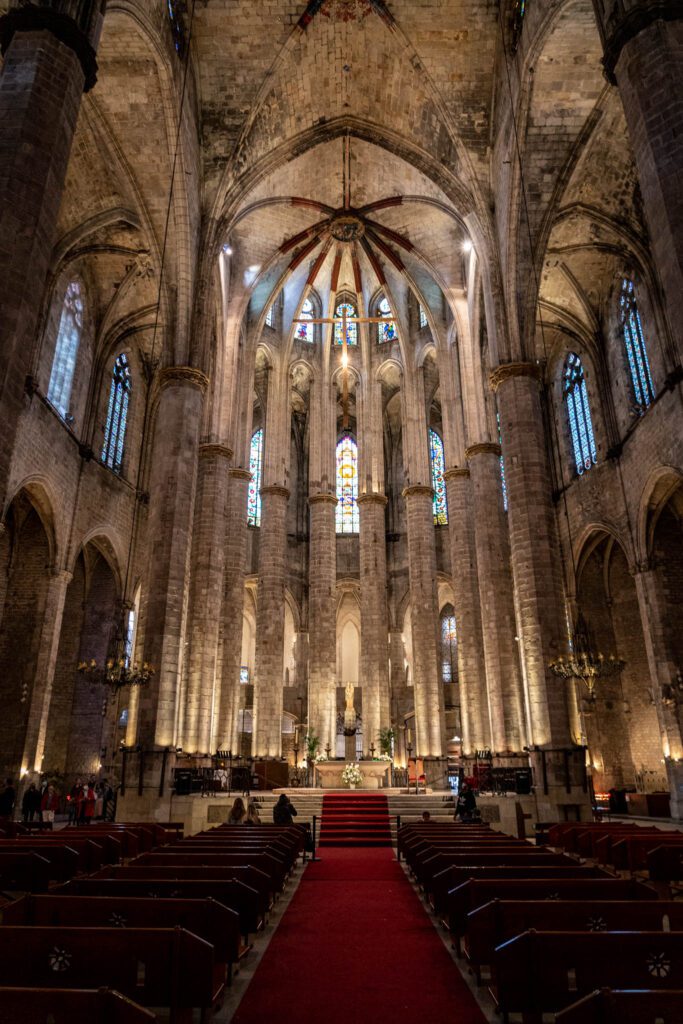
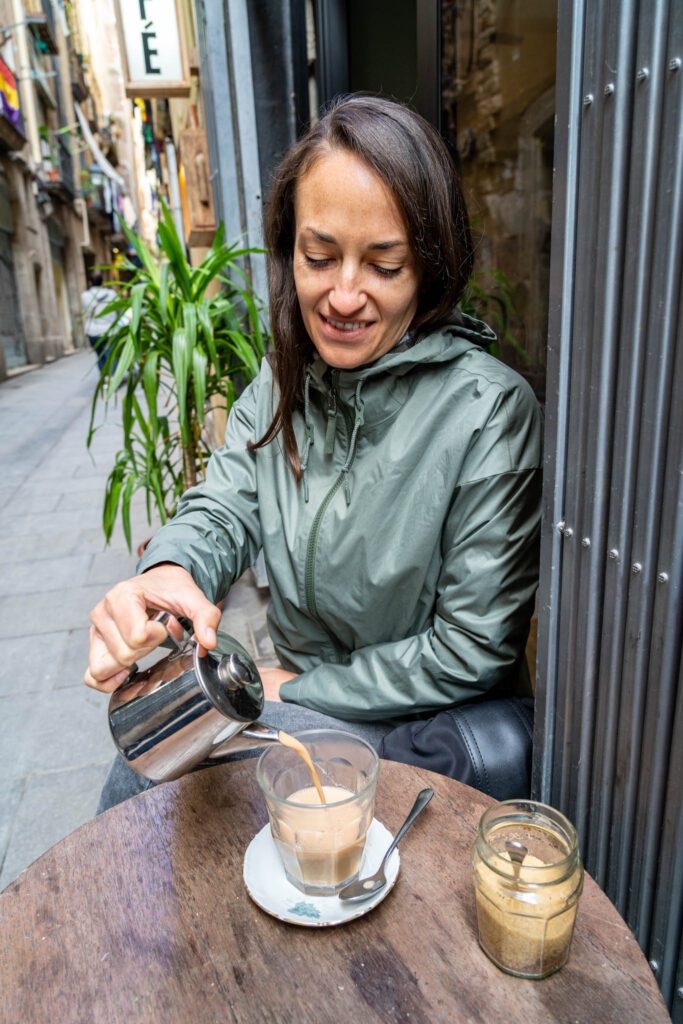
The Best Places to Stay in El Born
Mercer Hotel (Boutique Hotel): Nestled between El Born and the Gothic Quarter, and featuring views of the dome of the church of Santa María del Mar, the Mercer is an opulent 5-Star luxury hotel in an extremely popular location.
Inside Barcelona Apartments Esparteria (Apartments): Spacious apartments (except for the compact studio) in a great location. They have a range of sizes and layouts, including one and two bedroom apartments, a compact studio (with a kitchen), and a penthouse one bedroom. All apartments have kitchens and some have washing machines.
Decô Apartments Barcelona – Born (Apartments): Stylish apartments with exposed brick and plenty of natural light, these apartments are compact, but have everything you’ll need for a comfortable trip and still have plenty of space to spread out. Kitchens with a burner and coffee machine in all units, which come in various one bedroom layouts (with sofa beds that can sleep a couple of extra people), and a single huge three bedroom offering.
El Born Guest House by Casa Consell (Mid-Range Hotel): At the southeastern edge of the neighborhood, adjacent to Barceloneta and Parc de la Ciutadella, this charming guesthouse is stylish, central, and surprisingly affordable given the first two attributes I mentioned. Rooms are a little on the small side (especially the “small double rooms”), but if you’re planning on spending most of your time out exploring Barcelona, you don’t really need a big room anyway. Some rooms have cute little balconies, which look perfect for an afternoon glass of wine.
Pension Ciudadela (Guesthouse): A nice, family-run guesthouse (really, it’s a hostel without the bunk rooms) a few hundred feet away from Santa Maria del Mar, our favorite church in Barcelona after the Sagrada Familia. They have compact rooms – some with private external bathrooms, some ensuite – including family rooms with three beds (though the room is basically the same size, so it’s a tight squeeze!). Some rooms have balconies, and crucially, they all have A/C for the sweltering summer heat.
The Gothic Quarter: Narrow Alleyways and Lots of Tourists

The Gothic Quarter, home to the famous Las Ramblas, is the most heavily-visited area in the city. Of the words you hear spoken in the Gothic Quarter, the majority are likely to be in a language other than Spanish or Catalan.
Still, despite the fact that this entire area is built specifically to cater to tourists with shops selling knick-knacks and souvenirs that only tourists buy, there’s something very romantic about the narrow alleys and pedestrian-only streets of the Gothic Quarter.
The former Jewish Quarter (“El Call”), in particular, is one of our favorite parts of the city.
We’d highly recommend staying at least a block or two off of Las Ramblas if you do choose to stay here.
You’re going to pay a bit more than your room is worth anywhere in this part of the city since it’s so central and charming, but that issue is particularly bad around Las Ramblas, where hotels (and restaurants, for that matter) don’t even have to try to be good because of the location.
Pros and Cons of Staying in the Gothic Quarter
Pros:
- Romantic and Charming. Narrow alleys. Cobblestone streets. Plazas that emerge from seemingly out of nowhere. Once you leave Las Ramblas, it feels like you’re in a medieval town.
- THE Most Central Neighborhood. As you might imagine, the Gothic Quarter, which is the center of the Old Town, is the most central part of the city. Within about 15 minutes you can walk to El Raval, L’Eixample, and El Born, along with Barceloneta.
Cons:
- Basically Exclusively Tourists. Around every corner, you’ll find a pack of tourists. Sometimes hundreds all shuffling along listening to a guide on a headset, if there’s a cruise ship in town (spoiler: there probably is). Everything in the Gothic Quarter caters to tourists, though that’s not necessarily a bad thing – it’s just a specific vibe that’s worth knowing ahead of time.
- Las Ramblas. Is this the most famous street in all of Spain? It’s at the top of the list for sure. It’s worth strolling once, from Plaça de Catalunya to the Columbus statue with a stop at La Boqueria, but we wouldn’t eat, drink, or spend much time at all within a block or two of this heavily-trafficked, highly overrated boulevard.

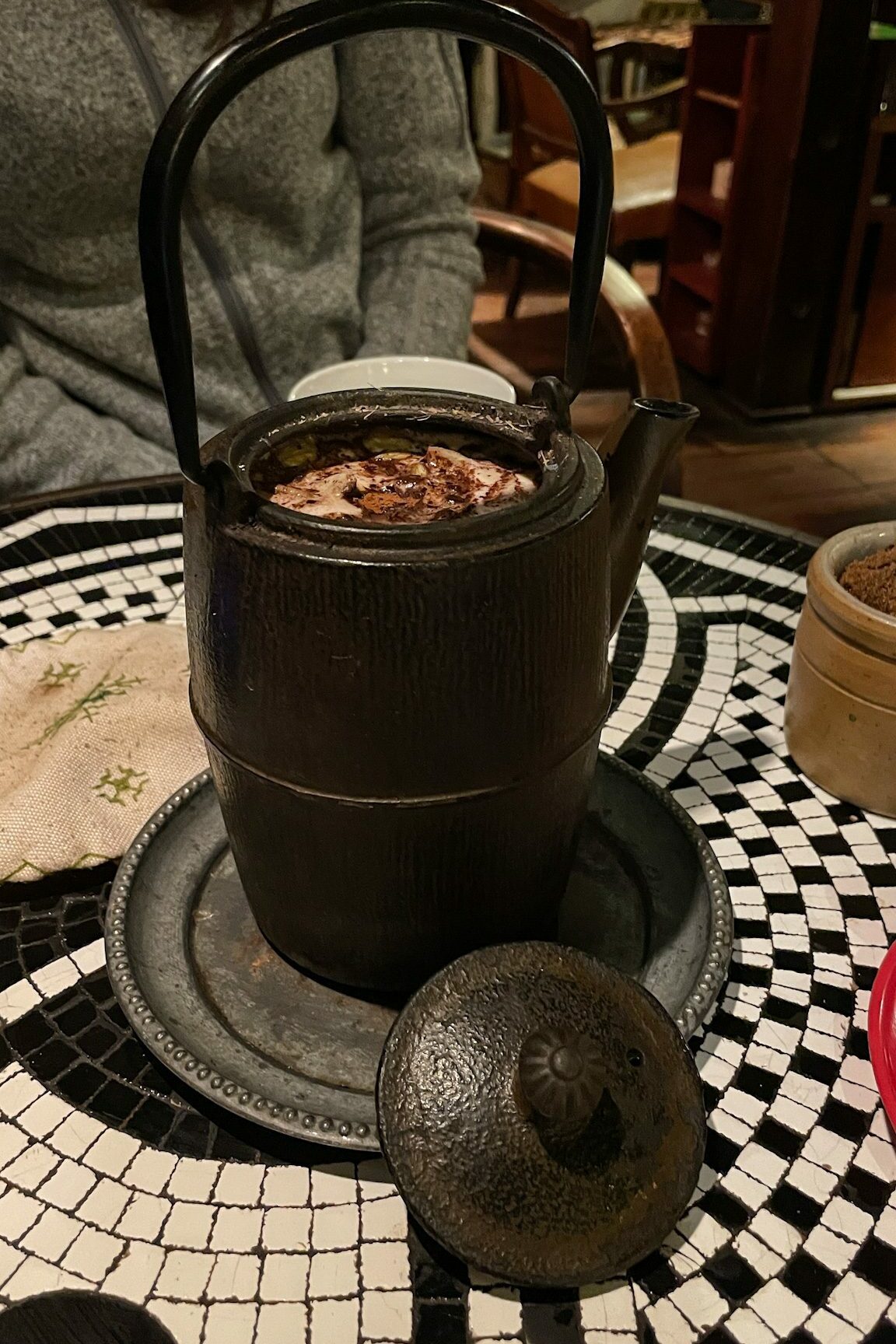
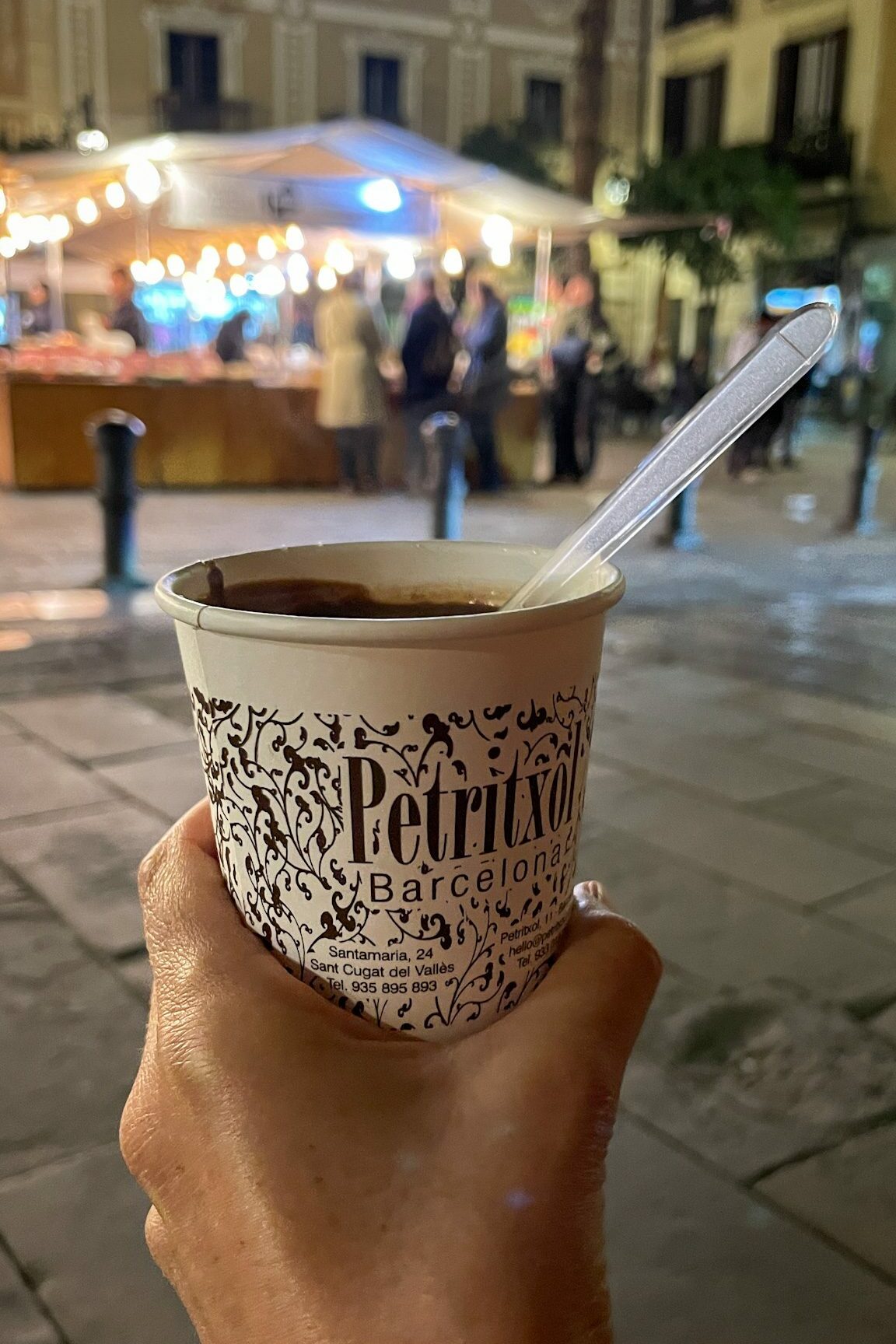
The Best Places to Stay in the Gothic Quarter
The Wittmore (Boutique Hotel): Although located right in the heart of the old city, the Wittmore feels more like an intimate speakeasy or a private club. Think cozy and intimate, with a bar and dining area that are great for meeting new friends. Adults only, so perfect for couples!
Colón Hotel Barcelona (Boutique Hotel): I’m not sure the location of this boutique hotel in Barcelona’s Gothic Quarter could be any better. Or, put another way, could the location BE any better (reference)? It’s right across the plaza from the Barcelona Cathedral, just a block from both the Mercado Santa Caterina and a couple of blocks from the Jewish Quarter, home of the aforementioned amazing tea shops. It’s a big hotel, with 129 rooms, and they range from “classic” to “design,” with the latter being both more stylish and more expensive. The important thing, we think, is the rooms with a Cathedral view, which is what you should probably focus on more than the design vs. classic distinction.
Ohla Barcelona (Luxury Hotel): If you’re looking for one of the best luxury hotels in the heart of Barcelona, look no further. The Ohla Hotel is opulent and luxurious, and the rooftop terrace and rooftop pool (an infinity pool, no less) is an excellent touch. The rooms are gigantic, at least compared to most other hotels in Barcelona, and they’re all stylish and comfortable. We like that the rooms have wooden floors (because carpets in hotel rooms are kind of gross, aren’t they?).
Aparthotel Arai 4* Superior (Apartments): Small – but gorgeous – apartments with kitchenettes and small touches of comfort like Nespresso machines and bathrobes and slippers. Plus, a rooftop terrace with a swimming pool! Given the style, amenities, and location, I expected the rooms to be more expensive than they are (though it should be said – they’re not exactly cheap).
El Raval: The Hipster’s Paradise
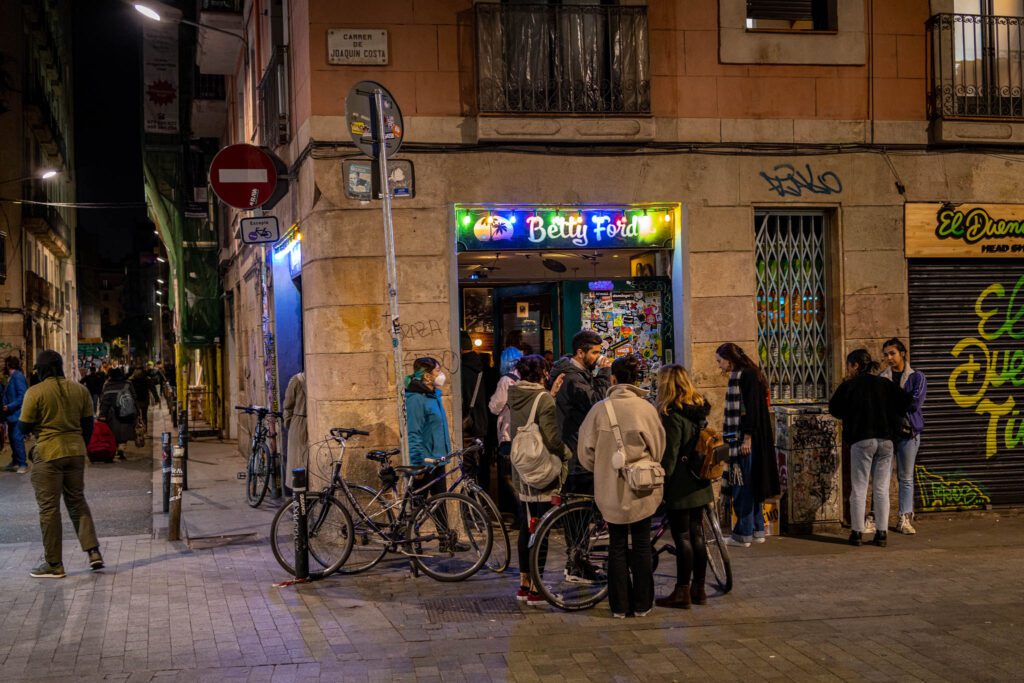
You’ll know you’re in El Raval because every other storefront is either a vintage clothing store, a record shop, or a tattoo artist’s studio.
I’m exaggerating, but not by much. These days, El Raval is firmly on the map, particularly for the younger, hipper crowd who are okay with the neighborhood’s slightly seedy past as they browse the vintage stores for their next pair of bell-bottom jeans (which are apparently in fashion again?) or retro sports jackets.
Despite its central location, El Raval is historically a neighborhood of immigrants, and that continues to be true to this day though it is gentrifying quickly. We saw signage decrying the influx of tourists and the associated noise, trash, and general disrespect that comes with them.
Like we’ve said before in this guide, you should only choose to stay in hotels (or aparthotels) here, rather than individual vacation rentals, which hurt local communities by increasing housing prices and destroying the sense of community in the area with a revolving door of one to two day residents.
Pros and Cons of Staying in El Raval
Pros:
- Central. The western edge of the neighborhood bumps up against Las Ramblas, which means you’ll be able to walk to almost every place you’re trying to go in the Ciutat Vella.
- Hip. As is usually the case when it comes to gentrifying neighborhoods, affordable areas first attract a class of artists who bring a range of businesses to the area that hipsters are going to love. Vintage shopping, coffee shops, and art galleries are a few of the categories that you’ll find in El Raval.
Cons:
- Safe but Seedy. While it’s safe, even at night, it definitely is a little rougher around the edges than most of Barcelona’s other, more manicured neighborhoods. Experienced travelers will be fine, but families with small kids and less experienced travelers might want to look elsewhere.
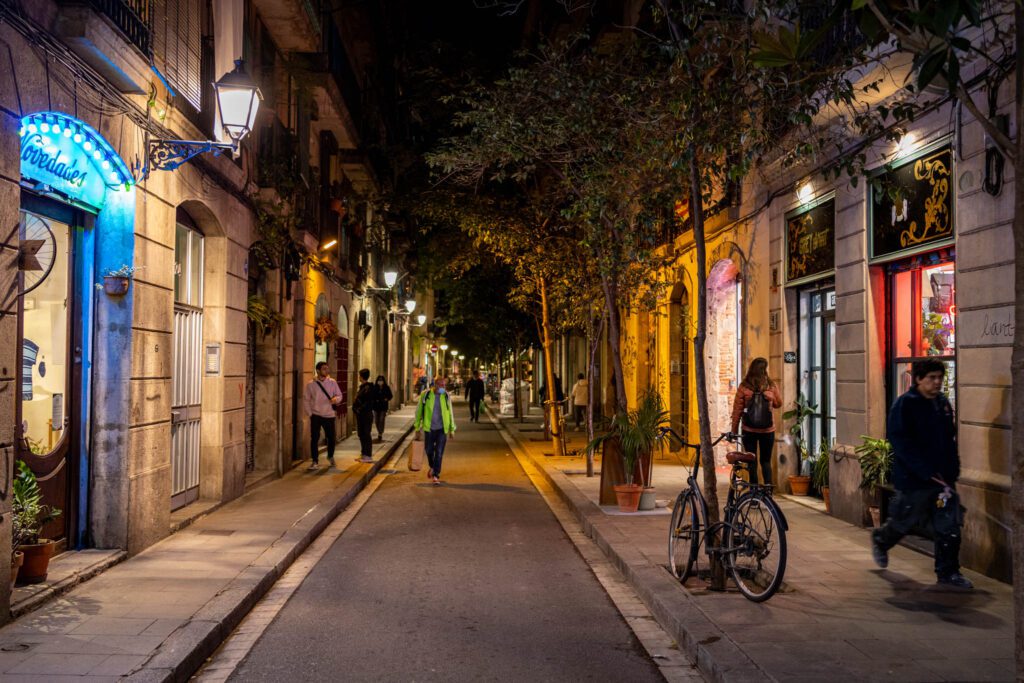
The Best Places to Stay in El Raval
Hotel Casa Camper (Boutique Hotel): By far, the number one choice in the neighborhood if you’re looking for a hotel. They have 40 rooms – 30 hotel rooms and 10 suites – all with exquisite design and layout. They have a fun concept called “tentempié” which, instead of a mini-bar, gives you access to a small mini-buffet with snacks and drinks. And it’s free. 24 hours a day! What a cool idea! And, of course, a terrace to soak in that Barcelona sun.
Happy Apartments (Apartments): A set of nice apartments in El Raval, ranging from one to two bedrooms. Apartments are big – plenty of space to spread out – and all have kitchens and washing machines. Some have terraces, too!
Eco Boutique Hostal Grau (Hostel, ish): This guesthouse is definitely niche, but a great budget option all the same. Hostal Grau labels itself as an “Eco Boutique”, and features rooms decorated using natural, organic materials, as well as efficient lighting and a water recycling system. Unlike most hostels, it’s all private rooms, some studios with small kitchenettes, some hotel-style rooms. They also have a set of bigger, more robust apartments with full kitchens, if you want a bit more space and want the option to cook for yourself.
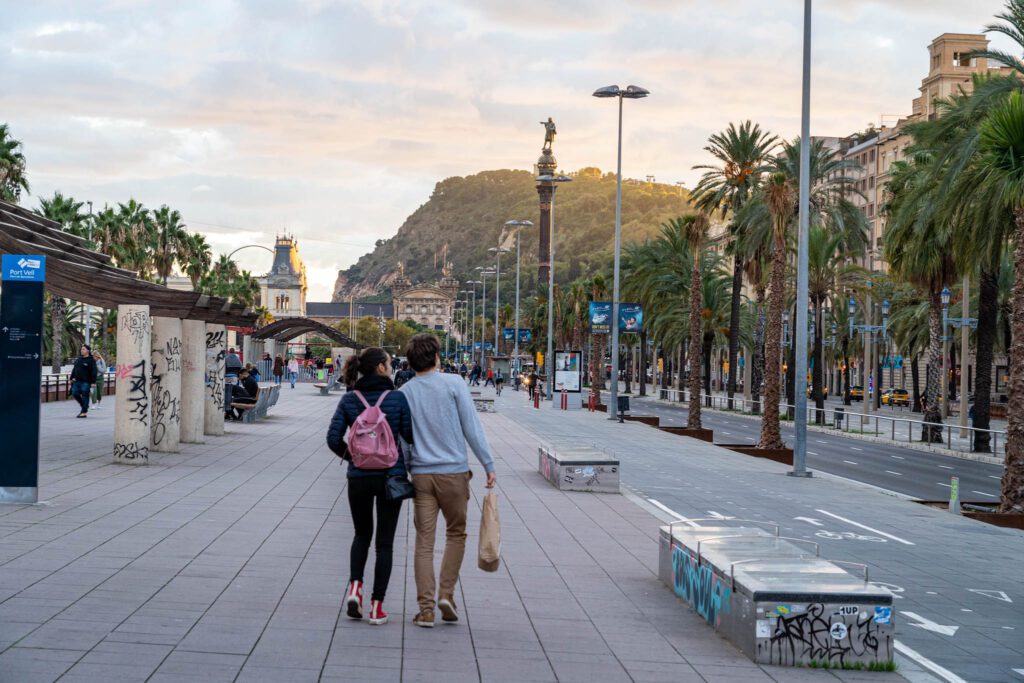
Where NOT to Stay in Barcelona
Basically, anywhere within about two blocks of La Rambla (with a few exceptions). It’s loud, you’ll pay more than the room is worth, and it’s the most touristy part of the city.
Generally, if you have a short stay in the city – less than five days – we’d recommend that you don’t stay outside of the main center (which we’d call Cituat Vella, Eixample, and Gràcia). There’s a ton to do and see in Barcelona, and you’re definitely going to want to be as central and well-connected as possible.
If you’re on a tight budget, we’d absolutely recommend finding a more affordable place to stay in one of the neighborhoods we go through below RATHER than trying to stay further out. We think you’ll thank us later.
An important note for Barcelona: short term rentals, like Airbnb for example, are effectively banned and illegal.
Do not stay in a short term rental through Airbnb. If you need an apartment (I do, given that I have Celiac Disease and need access to a kitchen), there are managed apartment complexes that are basically hotels that you can stay at.
See above for specific recommendations.
Let Us Help You Plan Your Amazing Trip to Spain!
We’ve got plenty of other detailed guides for our favorite places in Spain – from Barcelona, to Madrid and Andalusia – that we wrote to help you plan an incredible trip.
P.S.: If the link isn’t there, it means we’re still working on it and the guide will be up shortly. It takes a lot of time and effort to put together these detailed guides! Bear with us.
- Two Weeks in Spain: How to Plan an Amazing 14 Day Spain Itinerary
- 4 Days in Barcelona: How to Plan the Perfect Barcelona Itinerary
- Where to Stay in Barcelona: A Complete Guide to 5 Great Areas
- Gluten Free Barcelona: A Complete Guide for Celiacs
- Exactly How to Take an Amazing Day Trip to Girona From Barcelona
- 2 Days in Madrid: A Complete Guide to Planning Your Madrid Itinerary
- Where to Stay in Madrid: A Complete Guide to 5 Great Areas
- Gluten Free Madrid: A Complete Guide for Celiacs (Restaurants + Bakeries)
- Taking A Day Trip to Toledo From Madrid: A Complete Guide
- 2 Days in Granada: A Complete Guide to the Best Things to Do in Granada
- 2 Days in Seville: A Complete Guide to Planning a Seville Itinerary

Me, my husband and sister in law are planning a trip to Spain in May. I just want to comment that your travel blog is wonderful. I have read “14 days in Spain” and plan to follow your recommended itinerary. My sister in law also has celiac disease so it seems like it was meant to be that I found it! Plus I live in Portland! One question I have is : can I print out the info? I hope so!
Thanks, Jill
Hey Jill! You hit the trifecta – Portland, Celiac, and planning a trip to Spain. Cheers to that!
Unfortunately, we don’t have a great way to print out the info, but you can hit “print” and save as a PDF (the only problem is that our guides are really long and have ads, which you can’t really remove using that technique.